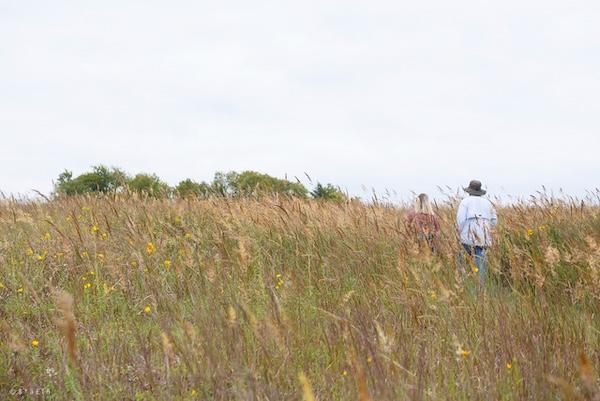
Tallgrass prairies, in the words of Clymer Meadow manager Brandon Belcher, have “world-class chiggers.” Photo by Stalin SM.
My husband and I were running ahead of schedule for a theater show one night in Fort Worth, so I had a great idea: "Let's go visit the prairie by the Chisholm Trail Recreation Center." We were dressed up nice, but it had a paved path.
A unique wildflower off the trail tantalized me. I had to see it up close. It was under a minute walk through medium-high grass to peruse and return to the paved trail. Then off to the theater we went.
About eight hours later, intense itching woke me from my sleep that night. I counted 52 chigger bites from a super brief exposure. I must have walked through a spot where a female chigger had birthed hundreds of babies and they'd yet to disperse. Horrors!
What could I have done differently?
• Not departed from the paved trail.
• Used the bug repellant I keep in my car.
• Brushed my legs off vigorously after returning to the trail.
• Entered the recreation building and used a wet paper towel to wipe down my legs and waistband.
You itch and learn. Let me share my hard-won knowledge from hiking. With all these tips, you’ll have complete hiking freedom to wander into waist-high prairies, lush forest understories, overgrown trails and other wild places. But for a casual trip to the park, just a few tips will suffice.
Much of the information can be found in my book, Wild DFW: Explore the Amazing Nature Around Dallas-Fort Worth, specifically in the field guide section under Bugs of Summer and in the Adventure Advice preamble to the hiking adventures section.
KNOW YOUR ENEMY
Chiggers are mites — Eutrombicula alfreddugesi and Eutrombicula splendens — but only the parasitic larval stage is worrisome. It takes a magnifying glass to see them: a hairy light orange or red round body with six legs.
Eutrombicula afreddugesi prefers dry areas — these are the ones in grass and vine patches. Eutrombicula splendens likes it damp — if you get an itchy rear after sitting on the ground or a tree stump, it's from this one.
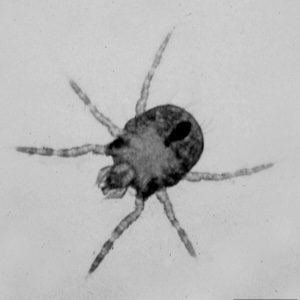 Chigger mite. Photo by Hansell F. Cross, Georgia State University. Courtesy of Bugwood.org.
Chigger mite. Photo by Hansell F. Cross, Georgia State University. Courtesy of Bugwood.org.
As I discovered, chiggers may be concentrated heavily in one area, with zero of them just a foot away. This is true even if you don't stumble into a chigger nest like I did. They’re just sporadic.
Chiggers are very sensitive to vibrations, odor and carbon dioxide, so when they detect you or a critter coming, they crawl to the tips of plants and hope you brush by. Walk quickly through tall grass. Stop in open areas and brush off your outer clothing to dislodge hitchhikers.
The nymph and adult stages of chiggers are free roamers and feed on insect eggs, teeny insects, or minute arthropods. We like them.
ALL ABOUT THE BITE
Now, let's get gross. Chigger larvae don't bite. They inject a necrotizing enzyme into your skin, which dissolves the cells. They form a straw of sorts and slurp you up. The process repeats until they're full. Then they drop off to molt into the nymph stages.
Dying cells are itchy business, causing lots of histamine to be released. But it takes a while. By the time you feel the itch, the chigger is long gone.
But chigger larvae are super-teeny. To inject into our skin, they require a slightly abraded area:
• Behind the knees.
• Wrinkles in dry or aging skin.
• Where clothing fits tightly, such as socks and waistbands.
Chiggers also feast on wildlife: mammals, birds, even reptiles.
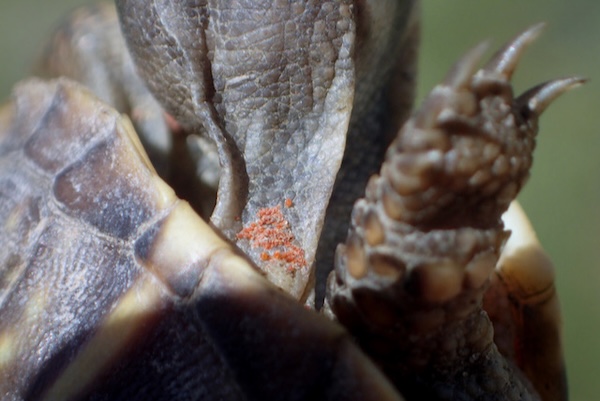 Chigger mite infestation of an ornate box turtle. Photo by Whitney Cranshaw, Colorado State University. Courtesy of Bugwood.org.
Chigger mite infestation of an ornate box turtle. Photo by Whitney Cranshaw, Colorado State University. Courtesy of Bugwood.org.
WHAT NOT TO DO
There is only one way to stop the itch: heal the skin. Which is absolutely counter to the conventional attack techniques.
Common remedies such as aromatics like camphor or menthols are counter-irritants that deflect your attention away from the itch. Try them before a meeting or bedtime, but overuse can delay healing the bite and prolong the itch.
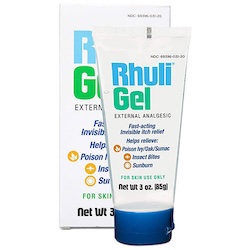 Aromatic products like RhuliGel can help with itching, but do not help heal the bites. Photo courtesy of manufacturer.
Aromatic products like RhuliGel can help with itching, but do not help heal the bites. Photo courtesy of manufacturer.
Applying nail polish to chigger bites arose because people assumed the chigger was still in the skin and should be suffocated, not knowing it had already departed. All nail polish applications do is place benzene, a component of most nail polishes, directly into the bloodstream. Since benzene is a carcinogen, that's not a good idea.
Anti-itch potions containing antihistamines, such as Benadryl, can help alleviate symptoms slightly but do nothing to heal the bites. Applying too much topical Benadryl, like when there are multiple widespread bites, can dangerously slow the heart rate and has led to the deaths of children. Over-the-counter steroids are ineffective.
HOW TO TREAT THE BITE AND END THE ITCH
The definitive way to alleviate the itch is to stop the skin necrosis.
Be kind to your skin. The poison ivy rash treatment and safe scratch methods outlined in my book, Itchy Business: How to Treat the Poison Ivy and Poison Oak Rash, Prevent Exposure, and Eradicate the Plant also apply to chigger bites.
Be aware three to eight hours after exposure for the telltale itchiness from chigger bites. Rub bites gently with rubbing alcohol or hydrogen peroxide to remove crustiness and help break down the necrotizing compound.
Apply genuine witch hazel (not the kind diluted with alcohol), which tightens the skin surface and helps bites heal faster.
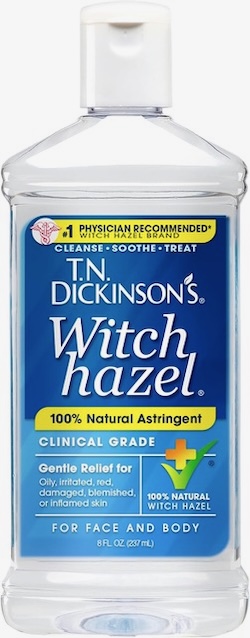
Look for witch hazel products without added alcohol or other dilutants. Photo courtesy of TN Dickinson .
Step 1: Calm the skin.
Alkaline topicals calm skin upsets. These include:
• Aloe vera gel or cut open a leaf and apply.
• Cucumber mash is cooling and calming. Rinse well afterward.
• Calamine lotion (clay is soothing). Apply and remove frequently. Do not allow to dry until brittle.
• Water-based creams and hydrosols with comfrey and calendula are effective. The Weleda calendula line is excellent, as is calendula hydrosol by Mountain Rose.
• Rash Relief Spray by Tecnu soothes with calendula and calms the itch with grindelia, but the alcohol may briefly sting open bites.
• Magnesium, such as found in aspirin-free Milk of Magnesia (applied topically) or magnesium salt baths, like Epsom salts. A mineral-salt bathtub soak can be just the ticket for bites in personal areas.
• Saltwater is alkaline. Simply Saline Wound Wash by Arm & Hammer is sterile saltwater. Simply Saline Wound Care 3-in-1 contains aloe vera, an antiseptic, and a numbing agent for bites.
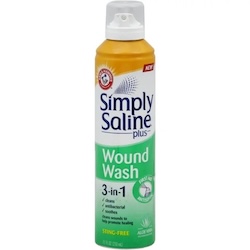
Saline products that dispense under pressure help saltwater penetrate the bites. Courtesy of manufacturer.
Cold compresses can reduce itch. Soak a washrag in salt water, place in a freezer for ten minutes, and apply for calming relief.
Step 2: Grow new skin cells.
Sulfur may be smelly, but it also nicely facilitates skin cell growth.
• Sulfur soap is helpful. Wash with it often using lukewarm water.
• Look for sulfur topicals not based on mineral oil or lanolin, such as Sulfur Ointment by Braunfels Labs.
• Look for sulfur products in the old-fashioned remedies section of your local drugstore. But online offers more options.
 Sulphur topicals help grow new skin cells. Sulfur Ointment. Courtesy of Braunfels Labs.
Sulphur topicals help grow new skin cells. Sulfur Ointment. Courtesy of Braunfels Labs.
Urea is a nitrogen-rich compound found in the epidermis of the skin. It facilitates skin cell growth. Animal protein contains urea, which kidneys filter from the blood to be excreted in urine. This is where the folk wisdom of urinating on wounds originates.
• It is best to use a truly sterile urea product containing other helpful skin-healing substances, such as Urea Skin Relief by The People's Pharmacy.
• Many facial products, particularly those that promote fresh or glowing skin, contain urea.
HOW TO PREVENT CHIGGER BITES
Best, of course, is to prevent chigger bites. In addition to moving swiftly through tall grass and avoiding sitting on damp soil, tree stumps, or logs, there are things you can do.
Attire to deflect chiggers.
• Dress in loose-fitting clothes.
• Wear long pants and closed-toe shoes.
• Select fabrics in a tight weave, especially socks.
• If the grass and greenery is not too high, tall galoshes are helpful. Tuck your pants inside.
Use several approaches to bug repellent.
• Chiggers hate sulfur. Fill an old crew sock with dusting sulfur available from nurseries. Whack it all over your bare legs, around your crotch and waist, and your armpits. Do this before leaving home.
• Coat your clothes with a permethrin or picardin spray. Do this before leaving home so you get a thorough soak. It is strong stuff that soldiers use. Do not apply to skin. Warning: Permethrin is highly poisonous to cats. Do not handle cats while wearing these clothes. They lack certain liver enzymes that break down the substances into harmless forms.
• At the outdoor site, coat your pants with dusting sulfur. Be aware that if walking through tall plants, it'll get knocked off.
• Spray the skin on your lower legs, forearms and waistband with a spray containing refined oil of lemon eucalyptus such as by Repel. Just as strong and long-lasting as DEET, while being safer and non-staining to clothes. Natural, non-refined essential oil products can potentially be effective if applied thoroughly and frequently.
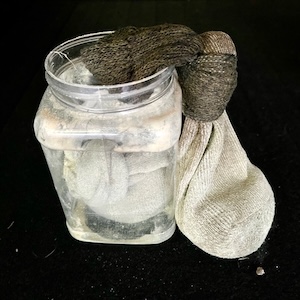 Keep the sulfur socks in a sealed container to stay dry. Photo by Amy Martin.
Keep the sulfur socks in a sealed container to stay dry. Photo by Amy Martin.
Don't take the chiggers home with you!
• After outdoor activities, changing into clean pants before driving home can help remove many chiggers. Place in a plastic bag in your car.
• If you can't change your pants, brush your clothes off vigorously. Keep a dust broom in your car. Take off and shake your shirt if possible. Sit on a bath towel to prevent chiggers getting into car upholstery.
• Bring a fresh pair of shoes to drive home. Store hiking shoes, belts or bags in a plastic bag or cardboard box.
• If you can't get to a shower quickly, wipe down under your clothes with a moist washcloth, especially feet, backs of knees, waistband and armpits.
• Put your outdoor clothes straight into the washer. If you use laundromats, leave your clothes outside until then.
• Wash down your hiking belt or pack with hot water. Brush off your hiking shoes with a stiff brush.
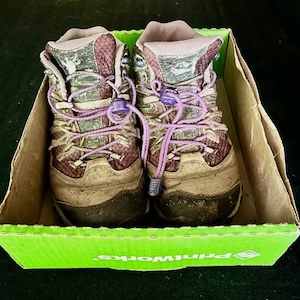 Keep your hiking shoes boxed in the back of vehicle. Photo by Amy Martin.
Keep your hiking shoes boxed in the back of vehicle. Photo by Amy Martin.
Get chiggers off your body.
• Take a shower with a strong water stream as soon as you can. The best option is to use Dawn dishwashing detergent, which contains surfactants that lift the chiggers to the water's surface, allowing them to be carried away. Follow the Dawn "blue shower" with a milder soap.
• Scrub briskly with a washcloth or net shower loofa.
• If not Dawn, use sulfur soap, highly aromatic soaps like those made with Thieves essential oil blend, or shower gels that make lots of suds.
• Focus on areas where the skin is folded, like armpits and crotches, or where your clothes bind firmly, like waistbands and around shoes.
• Shampoo your hair vigorously. Dry with a high-heat hair dryer.
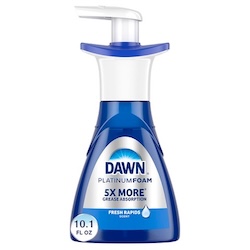 The foaming pump dispenser of Dawn is handy in the shower. Courtesy of manufacturer.
The foaming pump dispenser of Dawn is handy in the shower. Courtesy of manufacturer.
These tips also help with exposure to poison oak or ivy.
Disclaimer: This article is provided for educational purposes only and does not constitute providing medical advice or professional services. Please consult with a licensed physician for personal medical advice.
RELATED ARTICLES
Hiker's guide to chiggers and ticks
Dallas author's poison ivy book offers relief for the itchy
